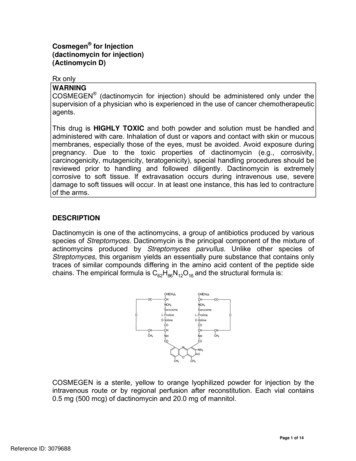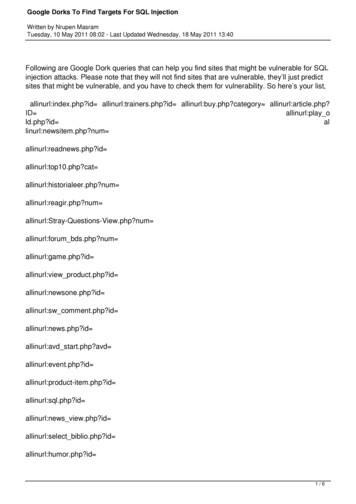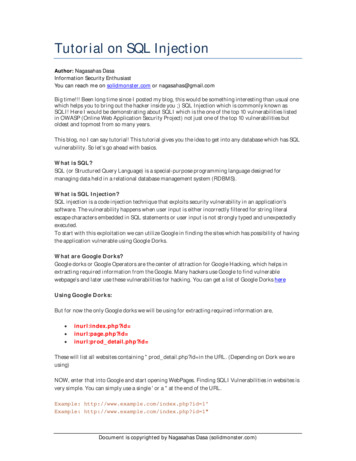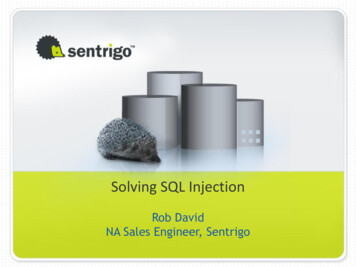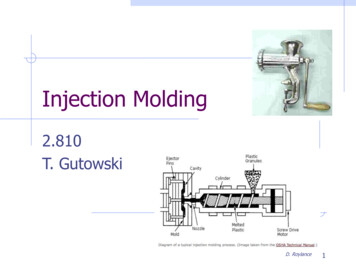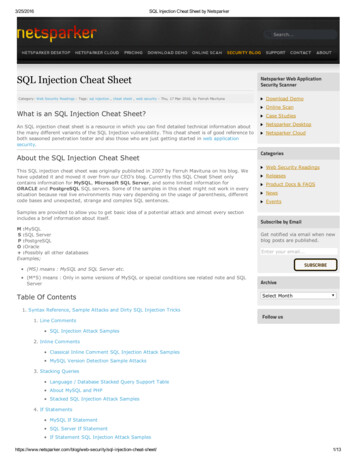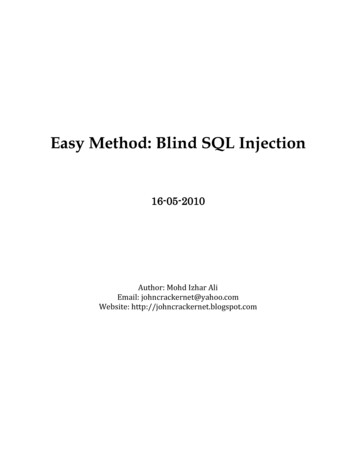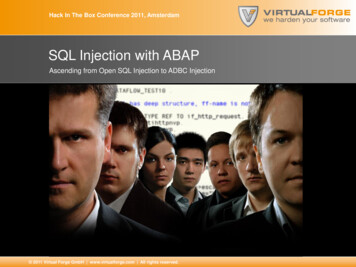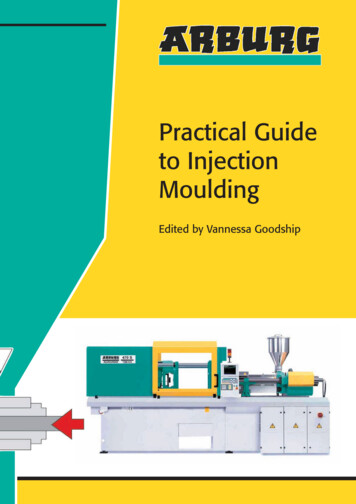
Transcription
Practical Guideto InjectionMouldingEdited by Vannessa Goodship
Practical Guide toInjection MouldingEdited byV. GoodshipRapra Technology LimitedShawbury, Shrewsbury, Shropshire, SY4 4NR, UKTel: 44 (0)1939 250383Fax: 44 (0)1939 251118http://www.rapra.net
2004, Rapra Technology Limited and ARBURG LimitedISBN: 1-85957-444-0All rights reserved. No part of this publication may be reproduced, stored in a retrieval system, ortransmitted in any form or by any means—electronic, mechanical, photocopying, recording orotherwise—without the prior permission of the publisher, Rapra Technology Limited, Shawbury,Shrewsbury, Shropshire, SY4 4NR, UK.Typeset, printed and bound by Rapra Technology Limited.
ContentsPreface1 Introduction1.1 The Big Picture1.2 Introduction to Injection Moulding1.3 The Injection Moulding Process1.3.1 Piston Injection Unit1.3.2 Reciprocating Screw Machine1.3.3 Breaking Down the Injection Moulding Cycle1.3.3.1 Plastication1.3.3.2 Filling1.3.3.3 Packing and Solidification1.4 Comparison with Other Moulding Methods1.4.1 Extrusion1.4.2 Compression Moulding1.4.3 Transfer Moulding1.4.4 Blow Moulding1.4.5 Film Blowing1.4.6 Intrusion Moulding1.4.7 Injection-Compression Moulding1.5 ConclusionFurther Reading2 Introduction to Plastics2.1 Introduction2.2 Structure and Typical Properties of Polymers2.3 Formation of Macromolecules2.4 Molecular Weight2.5 Plastics2.5.1 Thermoplastic2.5.2 Thermosets2.5.3 Elastomers2.5.3.1 Thermoplastic Elastomers (TPEs)2.5.4 The Formulation of Plastics2.5.5 The Binding Structure of Plastics2.6 The Effects of Processing on Thermoplastics2.6.1 Rheology2.6.2 Heat and Heat Transfer2.6.3 Physical and Chemical Change2.6.4 Fountain Flow2.7 Conclusion3 Injection Moulding Machinery3.1 Injection Units3.2 Piston (Plunger) Injection Unit3.3 Reciprocating Screw Piston Injection Unit3.3.1 Shot Capacity3.3.2 Plasticising Capacity3.3.3 The Feeding Hopper3.3.4 The Injection Cylinder3.4 Selection of the Injection Unit3.5 L/D Ratio3.5.1 Mixing Screws for Additives and Fast Cycling Machines3.5.1.1 Mixing Elements3.5.1.2 Extended Plasticising Cylinder3.5.2 Non-Return Valve3.6 General Information on Wear and Tear3.7 Unit Hardening Treatment3.8 The Nozzle3.9 Clamping Units3.9.1 Differential Piston System3.9.2 Mould Weights3.10 Selection of the Clamping Unit3.11 Mould Clamping Force3.11.1 Mould Clamping Force Level3.11.2 Mould Clamping Force and Mould 3333437383840414141
3.11.3 Setting Mould Closing and Clamping Force3.11.3.1 Mould Closing Force3.11.3.2 Clamping Force3.11.3.3 Second Clamping Force3.12 Data for Mould Closing Force3.13 Other Considerations3.14 International Standard for the Designation of Injection Moulding Machines4 Injection Mould Tooling Basics4.1 Types of Moulds4.1.1 Two-Plate Mould4.1.2 Stripper Mould4.1.3 Slide Mould4.1.4 Three-Plate Mould4.2 The Feed System4.2.1 Introduction4.2.2 Runner System4.2.3 Runner Shape4.2.4 Runner Layout4.2.4.1 Standard Runner4.2.4.2 Cold Runner4.2.4.3 Hot Runner4.3 Gate Design4.3.1 Sprue Gate4.3.2 Restricted Gate4.3.3 Side or Edge Gate4.3.4 Flash Gate4.3.5 Fan Gate4.3.6 Tab Gate4.3.7 Diaphragm Gate4.3.8 Spider Gate4.3.9 Ring Gate4.3.10 HOT TIP Gating4.4 Mould Temperature Control4.5 Ejection Systems4.6 Venting4.7 ConclusionFurther Reading5 Process Control Systems5.1 Introduction5.2 Explanation of the Different Concepts in Control and Regulation Technology5.2.1 Pump5.2.2 Motor5.2.3 Cylinder5.2.4 Directional Valves5.2.5 Pressure Valves5.2.6 Flow-Regulator Valves5.2.7 Location and Setting of Proportional Valves5.2.7.1 Valve Bodies5.2.7.2 Function of the Volume Proportional Valve5.2.7.3 Function of the Pressure Proportional Valve5.2.8 Check Valves5.2.9 Receivers5.3 General Information Concerning Control Units, Regulators,Position Regulation and Injection Process Regulation5.3.1 Control Unit5.3.2 Regulator5.3.3 Screw with Position Regulator5.3.4 Injection Process Regulation5.4 The User Interface5.4.1 Multitronica Control Unit – Standard Equipment5.4.2 Dialogica Control Unit – Standard Equipment5.4.3 Selogica Control Unit – Standard 0717171727373747474747577777878
6 Processing Amorphous and Semi-Crystalline Thermoplastics6.1 Introduction6.2 Amorphous Plastics6.2.1 Overview and Common Properties6.2.2 Standard Polystyrene (PS) Homopolymer6.2.3 Styrene Copolymers6.2.4 Modified Polyphenylene Oxide (PPO mod.)6.2.5 Polyvinyl Chloride (PVC)6.2.6 Cellulose Materials6.2.7 Polymethyl Methacrylate (PMMA)6.2.8 Polycarbonate (PC)6.2.9 Polyacrylates (PAR, PAE, APE, PEC)6.2.10 Polysulfones6.2.11 Polyetherimide (PEI)6.2.12 Polyamide Imide (PAl)6.3 Semi-Crystalline Plastics6.3.1 Overview and Common Properties6.3.2 Polyethylene (PE)6.3.3 Polypropylene (PP)6.3.4 Polyamide (PA)6.3.5 Polyacetals (POM)6.3.6 Polyterephthalates (Linear Polyesters)6.3.7 Polyphenylene sulfide (PPS)6.3.8 Polyfluoroolefins6.3.9 Polyacrylic Acid (PAA)6.3.10 Polyphthalamide (PPA)6.3.11 Polyaryl Ether Ketones (PAEK)6.3.12 Liquid Crystal Polymers (LCP)6.4 Conclusion7 Processing Thermoset, LSR and Ceramic Materials7.1 Thermosets7.1.1 Overview and Common Properties7.1.2 Materials for Screw Injection Moulding Machines7.1.3 Processing Procedures for Thermoset Plastics7.1.3.1 Compression Moulding7.1.3.2 Injection Moulding7.1.4 Screw Injection Machine for Thermosets7.1.5 Mould7.1.6 Guide Values for Cylinder and Mould Temperature Settings7.1.7 The Injection Unit for Granulated Thermosets7.1.8 The Injection Unit for Processing Moist Polyester7.1.9 Nozzle Temperature (if nozzle heating is applied)7.1.10 Common Thermoset Materials: Properties and Applications7.1.10.1 Phenol-Formaldehyde Compounds (PF)7.1.10.2 Urea-Formaldehyde Compounds (UF)7.1.10.3 Melamine-Formaldehyde Compounds (MF, MP)7.1.10.4 Unsaturated Polyester (UP, DAP)7.1.10.5 Epoxy Compounds (EP)7.2 Elastomer Injection Moulding Compounds7.2.1 Processing Procedures for Elastomeric Materials7.2.1.1 Compression Moulding7.2.1.2 Injection Moulding7.2.1.3 Injection Moulding Machines for Rubber Compounds7.2.1.4 Peripheral Device7.2.1.5 Mould7.2.2 Silicone Elastomers - Liquid Silicone Rubber (LSR) Systems7.2.2.1 Classification7.2.2.2 Crosslinking7.2.2.3 Processing of Two-Component LSR7.2.2.4 Advantages of Processing LSR Materials7.2.2.5 Injection Process7.2.2.6 Configuration of Injection Moulding Machines and Processing Data7.2.2.7 Specific Properties7.2.2.8 Crosslinking Reaction7.2.2.9 Structural Viscosity7.2.2.10 116116116117117118118118118119120120121
7.2.2.11 Internal Mould Pressure7.2.2.12 Shrinkage7.2.2.13 Tempering7.2.2.14 Preparation of LSR7.2.3 Processing Components for LIM7.2.3.1 Dosing Equipment for LSR7.2.3.2 Machine Technology7.2.3.3 Injection Unit7.2.3.4 Cylinder Module7.2.3.5 Non-Return Valve7.2.3.6 Auxiliary Heating Control Circuits7.2.3.7 Interface for Brush and Cleaner Units7.2.3.8 Handling Interface7.2.3.9 User-Programmable Inputs/Outputs7.2.3.10 Air Blast Equipment with Pressure Reducer7.2.3.11 Control Unit for Vacuum Pump7.2.3.12 Hydraulic/Pneumatic Cold Runner Control7.2.3.13 Protective Screens Made of PC7.2.3.14 Simple Cold Runner Nozzle7.2.3.15 Cold Runner Head7.2.3.16 Mould Technology7.2.4 Application of LSR Parts in Food Production7.2.5 Summary7.3 Processing of Ceramic and Metal Powder Materials7.3.1 Introduction7.3.2 Binder7.3.3 Processing7.3.3.1 Compression Moulding7.3.3.2 Injection Moulding7.3.4 Configuration of Injection Moulding Machines7.3.5 The Process Requirements7.3.5.1 Debinding and Sintering7.4 A Growing Market for Moulders8 Guide Values and Processing Instructions for the MostImportant Thermoplastic Injection Moulding Compounds8.1 Pre-Drying Material8.2 Examples of Moulding Parameters of Selected Materials8.3 Injection Moulding Process Parameters and Quality of Moulded Parts8.4 Injection and Mould Cavity Pressure8.5 Injection Pressure and Injection Time8.6 General Information on Filling Speed8.6.1 Initial Injection Speed8.7 Filling Speed and Orientation8.8 Effects of Too High Filling Speed8.9 Setting the Initial Injection Speed8.10 Plasticising8.10.1 Compound Temperature8.10.2 Cylinder Temperatures8.10.3 Nozzle Temperature8.10.4 Temperature Profile Guideline for Plasticising Cylinder8.10.5 Recommended Temperatures for Cylinder and Mould8.10.6 Measuring the Compound Temperature8.10.7 Screw Speed8.10.8 Back Pressure8.11 The Injection Stage8.11.1 Filling to Packing8.11.2 The Mould8.11.2.1 Mould Temperature: General Information8.11.2.2 Level of Mould Temperature8.11.2.3 Uniformity of Mould Temperatures8.11.2.4 Mould Temperature Patterns8.11.2.5 Temperature Control Devices8.11.2.6 Matching Temperature Control Units and Mould Maintenance8.11.2.7 Measuring the Mould Temperature - Checking the Uniformityof the Mould Temperature Control8.12 Recommended Values for Holding Pressure Time and Remaining Cooling 0151153153154154154157157157158158159160160161
8.13 Cycle Time8.14 Setting the Injection Moulding Machine9 Troubleshooting9.1 Introduction9.2 Troubleshooting Guide9.2.1 Detection and Classification of Defects9.2.2 Flow Charts for Troubleshooting9.2.3 Sink Marks9.2.4 Streaks9.2.4.1 Burnt Streaks (Brown or Silver)9.2.4.2 Moisture Streaks9.2.4.3 Colour Streaks9.2.4.4 Air Streaks/Air Hooks9.2.4.5 Glass Fibre Streaks9.2.5 Gloss/Gloss Differences9.2.6 Weld Line (Visible Notch or Colour Change)9.2.7 Jetting9.2.8 Diesel Effect (Burns)9.2.9 Record Grooves Effect9.2.10 Stress Whitening/Stress Cracks9.2.11 Incompletely Filled Parts9.2.12 Oversprayed Parts (Flashes)9.2.13 Visible Ejector Marks9.2.14 Deformation During Demoulding9.2.15 Flaking of the Surface Layer9.2.16 Cold Slugs/Cold Flow Lines9.2.17 Entrapped Air (Blister Formation)9.2.18 Dark Spots9.2.19 Dull Spots Near the Sprue9.3 Data Acquisition Record9.3.1 Using the Data Acquisition Record9.3.2 Data Acquisition Record for Optimising Moulded Parts9.3.2.1 Moulded Part Data9.3.2.2 Machine Settings and Defect Evaluation9.4 Case Studies of Injection Moulded Components9.4.1 Threaded Connecting Sleeves for Ink Drafting Apparatus9.4.2 Meter Cases9.4.3 Wristwatch Glass9.4.4 Alarm Clock Glass9.4.5 Glass Cover for Digital Gauge9.4.6 Plug Boards with Insert Pins9.4.7 Hair Slides9.4.8 Toothbrush Components9.4.9 Screw Cap with Conical Nipple9.4.10 Switch Housing9.4.11 Battery Housing10 Advanced Processing Techniques10.1 Introduction10.2 Multi-Component Moulding10.2.1 Co-Injection Moulding10.2.2 Bi-Injection Moulding10.2.3 Interval Injection Moulding10.3 Assisted Moulding10.4 Multi-Shot Moulding10.5 Over-Moulding10.6 Business Trends10.7 Material Selection10.8 Process Technology10.8.1 Multi-Component Injection Moulding10.8.2 Co-Injection Moulding10.8.2.1 Material Selection for Co-Injection Moulding10.8.2.2 Process Sequence10.8.2.3 Co-Injection Moulding: Different Techniques10.8.2.4 Part Design and Tooling Requirements for Co-Injection Moulding10.8.2.5 Rheology and Mould Filling: Why and How Co-Injection Moulding 13213214214214214214214215217217217218218219223223
10.8.2.6 Immiscible Materials Research in Co-Injection Moulding10.8.2.7 Setting Optimum Parameters10.8.2.8 Co-Injection Moulding Application Case Studies10.8.2.9 Recycling and Legislation10.8.2.10 Discussion and Conclusions10.8.3 Bi-Injection10.8.4 Interval Injection Moulding10.9 Assisted Moulding10.9.1 Gas Injection Moulding Technology (GIT)10.9.1.1 Process Technology10.9.1.2 Patent Situation10.9.1.3 Advantages and Disadvantages of GIT10.9.1.4 Process Variations in the Application of Gas Injection Moulding Technology10.9.1.5 Systems Technology for the Implementation of Gas Injection Technology10.9.1.6 Configuration Guidelines for GIT Moulding10.9.1.7 KoolGas 10.9.2 Water Assisted Injection Moulding (WAIM)10.10 Multi-Shot Moulding10.10.1 Machine Technology10.10.1.1 Injection Unit Configurations10.10.2 Core Back Moulding10.10.3 Rotating Tool10.10.4 Transfer Moulding10.10.5 Multi-Shot with a Single Injection Unit10.10.6 Materials for Muti-Shot Moulding10.10.6.1 Material Selection for Multi-Shot Moulding10.10.6.2 Material Process Order10.10.6.3 Using Thermoset Materials10.10.6.4 Liquid Silicone Rubber (LSR)10.10.6.5 Thermoplastic Elastomers (TPEs)10.10.7 Multi-Shot Application Case Studies10.10.7.1 Trio Knob10.10.7.2 Stanley Screwdriver10.10.8 Limitations to Multi-Shot10.11 Over-Moulding10.11.1 Insert Moulding10.11.2 Lost Core Moulding10.12 The Future?ReferencesFurther 249249249250250250250251251Appendix 1 Abbreviations and AcronymsAppendix 2 Trade Names, Specific Weight and Suppliers of Some Plastic Materials253257Index259
Practical Guide to Injection MouldingARBURG GmbH & Co.Postfach 11 0972286 LossburgGermanyTel.: 49 (0) 74 46 33-00Fax: 49 (0) 74 46 33 3365Website: http://www.arburg.comE-mail: contact@arburg.comARBURG Ltd.Tachbrook Park DriveWarwickCV34 6RHUnited KingdomTel.: 44 (0) 1926 457 000Fax: 44 (0) 1926 457 020Website: http://www.arburg.co.ukE-mail: uk@arburg.comDear Reader,ARBURG have been manufacturing injection moulding machines since 1954. The ARBURGALLROUNDER range of injection moulding machines that are specified and supplied today can betraced back to an original model designed and built by one of the two sons of our founder Arthur Hehl.Karl Hehl introduced a machine for small scale production of camera flash bulb leads encapsulated inpolymer. At that time they were typical
7.1.4 Screw Injection Machine for Thermosets 109 7.1.5 Mould 109 7.1.6 Guide Values for Cylinder and Mould Temperature Settings 109 7.1.7 The Injection Unit for Granulated Thermosets 111 7.1.8 The Injection Unit for Processing Moist Polyester 111 7.1.9 Nozzle Temperature (if nozzle heating is applied) 111 7.1.10 Common Thermoset Materials: Properties and Applications 112 7.1.10.1 Phenol .
![[Injection Moulding Calculations]](/img/6/124472923.jpg)
